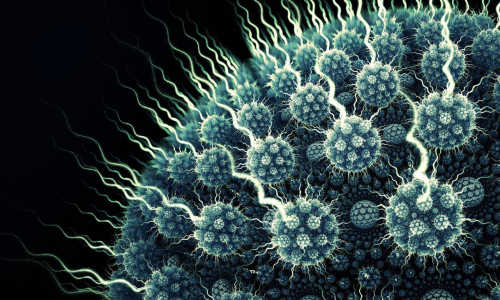“The word, virus, connotes morbidity and mortality, but that bad reputation is not universally deserved,” said Marilyn Roossinck, PhD, Professor of Plant Pathology and Environmental Microbiology and Biology at the Pennsylvania State University, University Park. “Viruses, like bacteria, can be important beneficial microbes in human health and in agriculture,” she said. Her review of the current literature on beneficial viruses appeared ahead of print April 24 in the Journal of Virology, which is published by the American Society for Microbiology.
In sharp contrast to the gastrointestinal distress it causes in humans, the murine (mouse infecting) norovirus plays a role in development of the mouse intestine and its immune system, and can actually replace the beneficial effects of certain gut bacteria when these have been decimated by antibiotics. Normal, healthy gut bacteria help prevent infection by bacteria that cause gastrointestinal illness, but excessive antibiotic intake can kill the normal gut flora, and make one vulnerable to gastrointestinal disease. However, norovirus infection of mice actually restored the normal function of the immune system’s lymphocytes and the normal morphology of the intestine, said Roossinck.
Mammalian viruses can also provide immunity against bacterial pathogens. Gamma-herpesviruses boost mice resistance to Listeria monocytogenes, an important human gastrointestinal pathogen, and to Yersinia pestis, otherwise known as plague. “Humans are often infected with their own gamma-herpes viruses, and it is conceivable that these could provide similar benefits,” said Roossinck.
Latent herpesviruses also arm natural killer cells, an important component of the immune system, which kill both mammalian tumor cells, and cells that are infected with pathogenic viruses.
The gastrointestinal tracts of mammals are plush with viruses. So far, little is known about how these viruses affect their hosts, but their sheer number and diversity suggest that they have important functions, said Roossinck. For example, GI viruses that infect bacteria–known as phage–may modulate expression of bacterial genes involved in host digestion.
Recent research shows that bacteriophage stick to the mucus membranes of many metazoans (the class “Animalia,” which includes everything from worms to wombats). And mucus membranes, Roossinck points out, are the points of entry for many bacterial pathogens, suggesting that they provide the first line of defense against invading bacteria.
Viruses also provide a variety of services for plants. A few plants grow in the hot soils surrounding the geysers and the “Artists’ Paintpots” of Yellowstone National Park. One such plant, which is a type of tropical panic grass, is a symbiosis that includes a fungus that colonizes the plant, and a virus that infects that fungus. All three members of this symbiosis are necessary for survival in soils simmering at more than 122 degrees Fahrenheit.
In the laboratory, Roossinck has created symbioses between the same virus-infected fungus and other plants. This has enabled every plant her group has tested to survive at these elevated soil temperatures, including tomato, she says, noting that she has pushed the soil temperature to 140 degrees without killing the plant.
Investigators have also found that certain viruses can render some plants drought tolerant, and at least one example of virally-conferred cold tolerance has been discovered– discoveries that could become useful for expanding the ranges of crops.
Plants are often infected with “persistent viruses” that are passed down from generation to generation, perhaps over thousands of years, with viruses that are transmitted to nearly 100 percent of their plant progeny, but that have never been shown to be transmitted from one plant to another. “One such virus, white clover crytpic virus, suppresses formation of nitrogen-fixing nodules when adequate nitrogen is present in the soil, saving the plant from producing a costly organ when it is not needed” said Roossinck.
Other beneficial viruses are the ancient retroviruses that long ago made a permanent home in the genome, or that left genes therein, said Roossinck. “The mammalian genes for syncitin, essential in the establishment of the placenta, are retroviral env genes that were incorporated on several different occasions,” Roossinck writes. “They even function differently in ruminants compared to other mammals… these elements are considered viral fossils that can help us understand the deep evolution of viruses.”
“Viruses are beyond a doubt the coolest things I have ever encountered,” said Roossinck. “They do truly amazing things with very little genetic information. I was always a little disturbed at the bad rap they get, so it was very exciting for me to find good ones.”
Story Source:
The above story is based on materials provided byAmerican Society for Microbiology





